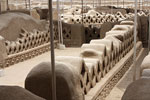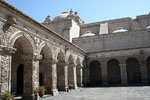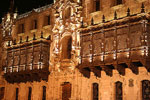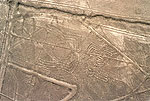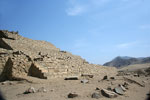World Heritage Sites in Peru
An exciting journey through the unique Peruvian heritage listed by UNESCO as a World Heritage Site, which lists all the cultural and natural protected origin, historical context, its location and current status. The World Heritage of Peru is an invitation to know and empathize with ancient archaeological monuments, historic sites where they fuse Spanish colonial architecture and the native, unique natural scenery. These are sites and places of beauty and importance as Machu Picchu and Caral or Manu National Park and the Huascaran National Park.
Added to these are the places that Peru has been proposed and are under evaluation, as the historical center of Trujillo (1996), the archaeological complex of Pachacamac (1996), the Lake Titicaca (2005), the Qhapaq Ñan (2001 ), the historical center of Cajamarca (2002). And intangible cultural heritage, Peru has postulated the Scissors Dance, dance Huaconada of Mito (2010) and the Peruvian Cuisine (2011).
Below is a list of places in Peru declared a World Heritage Site:
Historic Sanctuary of Machu Picchu
Cultural and Natural Site - UNESCO 1983: Machu Picchu stands 2,430 m above sea-level, in the middle of a tropical mountain forest, in an extraordinarily beautiful setting. It was probably the most amazing urban creation of the Inca Empire at its height; its giant walls, terraces and ramps seem as if they have been cut naturally in the continuous rock escarpments. The natural setting, on the eastern slopes of the Andes, encompasses the upper Amazon basin with its rich diversity of flora and fauna.
Cuzco City
Cultural Site - UNESCO 1983: Situated in the Peruvian Andes, Cuzco developed, under the Inca ruler Pachacutec, into a complex urban centre with distinct religious and administrative functions. It was surrounded by clearly delineated areas for agricultural, artisan and industrial production. When the Spaniards conquered it in the 16th century, they preserved the basic structure but built Baroque churches and palaces over the ruins of the Inca city.
Chavín de Huantar
Cultural Site - UNESCO 1985: The archaeological site of Chavín gave its name to the culture that developed between 1500 and 300 B.C. in this high valley of the Peruvian Andes. This former place of worship is one of the earliest and best-known pre-Columbian sites. Its appearance is striking, with the complex of terraces and squares, surrounded by structures of dressed stone, and the mainly zoomorphic ornamentation.
Huascarán National Park
Natural Site - UNESCO 1985: Situated in the Cordillera Blanca, the world's highest tropical mountain range, Mount Huascarán rises to 6,768 m. above sea-level. The deep ravines watered by numerous torrents, the glacial lakes and the variety of the vegetation make it a site of spectacular beauty. It is the home of such species as the spectacled bear and the Andean condor.
Chan Chan
Cultural Site - UNESCO 1986: The Chimú Kingdom, with Chan Chan as its capital, reached its apogee in the 15th century, not long before falling to the Incas. The planning of this huge city, the largest in pre-Columbian America, reflects a strict political and social strategy, marked by the city's division into nine 'citadels' or 'palaces' forming autonomous units.
Manu National Park
Natural Site - UNESCO 1987: This huge 1.5 million-ha park has successive tiers of vegetation rising from 150 to 4,200 m above sea-level. The tropical forest in the lower tiers is home to an unrivalled variety of animal and plant species. Some 850 species of birds have been identified and rare species such as the giant otter and the giant armadillo also find refuge there. Jaguars are often sighted in the park.
Historic Centre of Lima
Cultural Site - UNESCO 1988: Although severely damaged by earthquakes, this 'City of the Kings' was, until the middle of the 18th century, the capital and most important city of the Spanish dominions in South America. Many of its buildings, such as the Convent of San Francisco (the largest of its type in this part of the world), are the result of collaboration between local crafts people and others from the Old World.
Rio Abiseo National Park
Cultural and Natural Site - UNESCO 1990: The park was created in 1983 to protect the fauna and flora of the rainforests that are characteristic of this region of the Andes. There is a high level of endemism among the fauna and flora found in the park. The yellow-tailed woolly monkey, previously thought extinct, is found only in this area. Research undertaken since 1985 has already uncovered 36 previously unknown archaeological sites at altitudes of between 2,500 and 4,000 m, which give a good picture of pre-Inca society.
Lines and Geoglyphs of Nazca and Pampas de Jumana
Cultural Site - UNESCO 1994: Located in the arid Peruvian coastal plain, some 400 Km south of Lima, the geoglyphs of Nazca and the pampas of Jumana cover about 450 km2 . These lines, which were scratched on the surface of the ground between 500 B.C. and A.D. 500, are among archaeology's greatest enigmas because of their quantity, nature, size and continuity. The geoglyphs depict living creatures, stylized plants and imaginary beings, as well as geometric figures several kilometers long. They are believed to have had ritual astronomical functions.
Historic Centre of the Arequipa City - The White City
Cultural Site - UNESCO 2000: The historic centre of Arequipa, built in volcanic sillar rock, represents an integration of European and native building techniques and characteristics, expressed in the admirable work of colonial masters and Criollo and Indian masons. This combination of influences is illustrated by the city's robust walls, archways and vaults, courtyards and open spaces, and the intricate Baroque decoration of its facades.
Taquile Island and its Textil Art
Oral and Intangible -
UNESCO 2005: Taquile Island is known for its textile art, which is produced as an everyday activity by both men and women, regardless of their age, and worn by all community members. The weaving tradition on Taquile island goes back to the ancient Inca, Pukara and Colla civilizations; it thus keeps elements from pre-Hispanic Andean cultures alive in the present. Besides Aymara and Spanish, the Taquile people speak Quechua, an indigenous language of Peru.
Sacred City of Caral
Cultural Site - UNESCO 2009: The 5000-year-old 626-hectare archaeological site of The Sacred City of Caral-Supe is situated on a dry desert terrace overlooking the green valley of the Supe river. It dates back to the Late Archaic Period of the Central Andes and is the oldest centre of civilization in the Americas. Exceptionally well-preserved, the site is impressive in terms of its design and the complexity of its architectural, especially its monumental stone and earthen platform mounts and sunken circular courts. One of 18 urban settlements situated in the same area, Caral features complex and monumental architecture, including six large pyramidal structures. A quipu (the knot system used in Andean civilizations to record information) found on the site testifies to the development and complexity of Caral society. The city's plan and some of its components, including pyramidal structures and residence of the elite, show clear evidence of ceremonial functions, signifying a powerful religious ideology.
Argentina, Bolivia, Chile, Colombia, Ecuador and Peru share a common cultural heritage of outstanding value: the Qhapaq Ñan, or Main Andean Road. For the past three years the World Heritage Centre has been assisting these countries in a pioneering project: the preparation of a single nomination for the inclusion of Qhapaq Ñan in the World Heritage List entailing an original and innovative regional cooperation process. Qhapaq Ñan otherwise know as the Main Andean Road, was the backbone of the Inca Empire's political and economic power. The whole network of roads over 23,000 Km in length connected various production, administrative and ceremonial centres constructed over more than 2,000 years of pre-Inca Andean culture. The Main axis of the route, also known as the Royal Road runs along the peaks of the Andes which is at it's most discernable between Quito and Mendoza. In addition to this backbone over the highest peaks, other roads also run in a north-south direction along the Pacific coast. The Inca Empire organized its network on a continent-wide scale; its roads are an invaluable expression of the organizing and planning spirit of the available labour force and constituted a key instrument in unifying the Empire physically and organizationally.
The scissors dance
Inscribed in 2010 on the Representative List of the Intangible Cultural Heritage of Humanity. The scissors dance is performed by inhabitants of Quechua villages and communities in the south-central Andes of Peru, and now in urban settings. This competitive ritual dance is performed during dry months coinciding with the main phases of the agricultural calendar. The scissors dance takes its name from the pair of polished iron rods, resembling scissors blades, wielded by each dancer in his right hand. Together with a violinist and a harpist, a dancer forms a cuadrilla (team) that represents a given village or community. To perform, two or more cuadrillas face each other, and the dancers must strike the blades together in time to the rhythm of the accompanying musicians, while performing a choreographed duel of step-dancing, acrobatics and increasingly demanding movements. The competition or atipanakuy may last up to ten hours, and physical ability, quality of the instruments, and expertise of the accompanying musicians, are all evaluated to determine the winner. The dancers wear outfits embroidered with golden fringes, multicoloured sequins and small mirrors, but while in costume are forbidden from entering churches because of the tradition that their abilities are the result of a pact with the devil. Regardless, the scissors dance has become a popular part of Catholic festivities. The physical and spiritual knowledge implicit in the dance is passed on orally from master to student, with each cuadrilla of dancers and musicians giving pride to its village of origin.
Huaconada, ritual dance of Mito
Inscribed in 2010 on the Representative List of the Intangible Cultural Heritage of Humanity. Huaconada is a ritual dance performed in the village of Mito in the province of Concepción in the central Peruvian Andes. Every year, on the first three days of January, masked men known as huacones perform a choreographed series of dances in the centre of the town. The huacones represent the former council of elders, and for the duration of Huaconada they become the town's highest authority. The tronador (whip) they carry and their masks emphasize this role, the latter characterized by accentuated noses that evoke the beak of the condor, creature that represents the spirit of the sacred mountains. The dance involves two types of huacones: elders who wear traditional costumes and finely-carved masks inspiring respect and fear; and modern huacones who wear colourful dress, their masks embodying terror, sadness or mockery. During Huaconada, the modern huacones dance circumscribed steps around the elders, who have greater freedom to dance improvised movements because of their seniority. An orchestra plays different rhythms, beating out time on a small indigenous drum called a tinya. Huaconada synthesizes distinctive elements from the Andes and Spain while incorporating new, modern elements. Only those of good conduct and moral integrity may become huacones. The dance is traditionally passed on from father to son, while clothing and masks are also inherited.
Source: UNESCO / World Heritage Convention.
WORLD HERITAGE SITES IN PERU - SEE ALSO:
- Ancient Treasures of Peru
- Top Ten Destinations in Peru
- Machu Picchu
- Caral, the oldest city in America
- Nazca Lines
